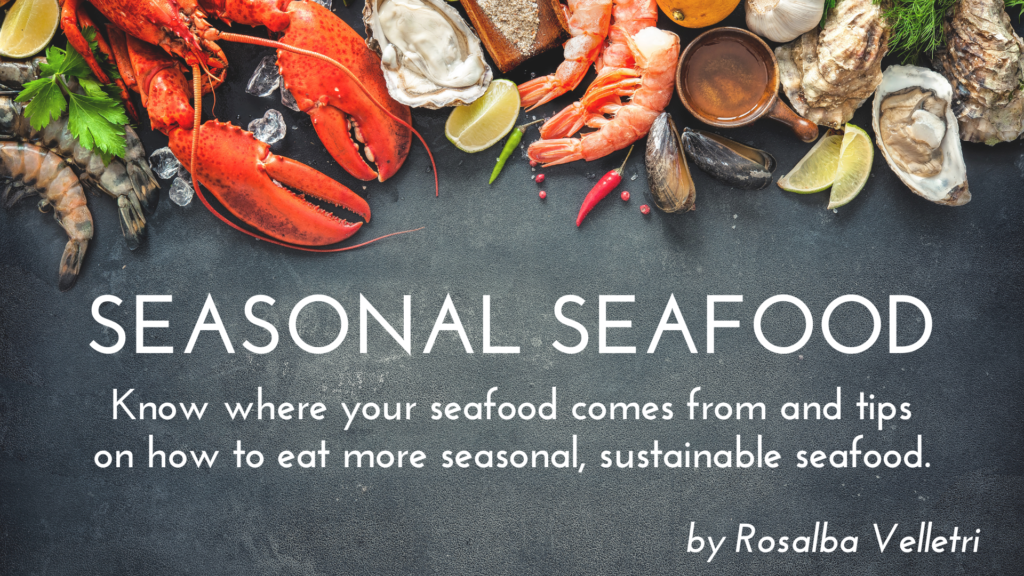by Rosalba Velletri

In the last few years there has been a big emphasis on the seasonality of food especially in relation to fruit and vegetables. Every day we hear that we should eat according to the season; fruit and vegetables that are in the garden now, are fresh and have higher nutritional value, low food miles and a low carbon footprint because they don’t have to come from the other side of the world.
The same goes for seafood. Have you ever thought about the seasonality of seafood? The fish we eat is seen as a source of protein, a lighter meal option, a source of healthy fats, or simply as food. However do you know where your fish comes from? Do you have a trusted fishmonger that helps you choose what fish to buy, or do you know who caught your fish?
We are blessed in Western Australia to have some of the best fish and crustaceans, think of Albany Squid or Exmouth Prawns and Lancelin Lobsters. When we go shopping or eat out, it is important to remember that our food choices have an influence on the global food system and the same goes for seafood. It is time to start asking questions. I remember on one of our trips to Albany we went out for dinner and ordered Squid thinking that we would be served Albany Squid. When we asked the waiter where the squid came from, he said that they were imported frozen squid. How disappointing!!!! But I believe if more people asked those questions the food scene would have to change and the restauranteurs especially would have to start learning about local, fresh, seasonal seafood as well.
85% of commercial fishing in WA is conducted in remote coastal areas and mainly by small family run businesses and our Fisheries Department sets rules to carefully manage our natural resources to ensure our fish stock remain sustainable. They impose number and size limits and specific fishing seasons for some species, however we can all take a more active role.
TIPS
- Choose species that are not overfished and small fish because they reach maturity and reproduce more quickly, helping stocks regenerate faster. Big fish grow very slowly and have a long–life expectancy, meaning they’re more vulnerable to overfishing and more troubles in the ecosystem. They also have higher levels of mercury.
- Buy fish that is “in season” and at the “right size”, to ensure reproduction is allowed and that stocks may be kept at healthy levels.
- Buy a whole fish instead of fillets and you can see if the fish is fresh. Also, the bones will give more flavour to your cooking.
- Eat lesser-known species, they are usually sold at very low prices. These fish are often very tasty. Be curious and explore new tastes!
- Avoid farmed fish. Fish Farming seems to overlook seasonality and offers a suitable amount of one or two types of fish all year round. Think about Salmon and Barramundi, they are the hype because they are marketed as good source of essential fatty acids, very important for our health, however being farmed implies the use of chemicals to keep them alive (ie: feeds, antibiotics, formaldehyde, etc.).
- Pollute less! Local fish means less transport and packaging, and so less pollution.
To know what fish are in season you can search the internet for a Seasonal Seafood Calendar or better still, and in true Slow Food style, find a trusted fishmonger that supports small fishermen and consequently the whole ecosystem.
EASY FISH RECIPE – TAILOR WITH WHITE WINE
Ingredients:
- 1 TAILOR per person
- Plain flour
- Extra Virgin Olive Oil, Sea Salt, Garlic, Fresh Parsley
- 1 glass Dry White Wine
Method:
Scale and gut the Tailor, or ask your fishmonger to do that for you. Wash the fish and pat dry with a paper towel. Lightly flour the fish on both sides.
Place some extra virgin olive oil in a deep frypan, add some chopped garlic and fry gently for a couple of minutes. Place the fish in the frypan and when it starts sizzling sprinkle with some sea salt, carefully turn the fish over, sprinkle with some more sea salt, add the wine, cover with a lid and let the fish cook on medium heat. This shouldn’t take long, approximately 15 minutes; you can check when it’s cooked by pulling out one of the fins on the back of the fish with tongs, if the fin comes out easily the fish is cooked.
Gently lift the fish from the frypan and place it on a serving plate, sprinkle with chopped fresh parsley and serve with the sauce from the frypan and a green salad.
BUON APPETITO!
